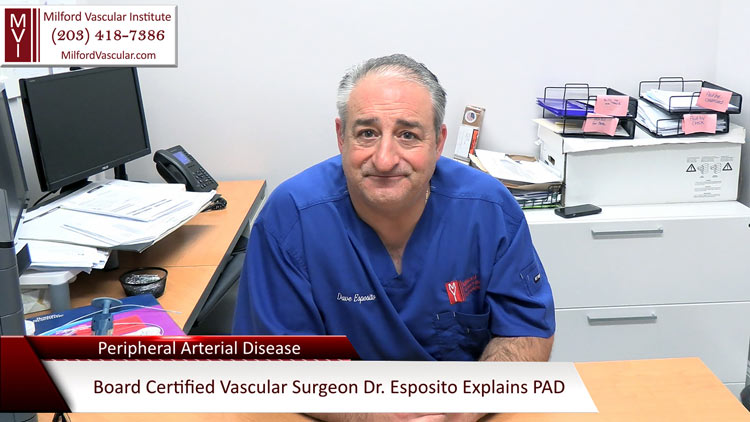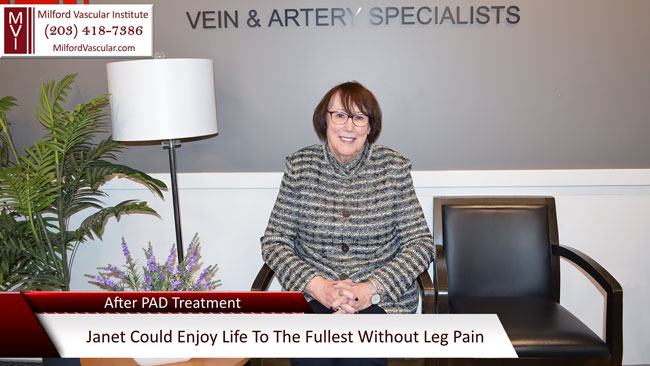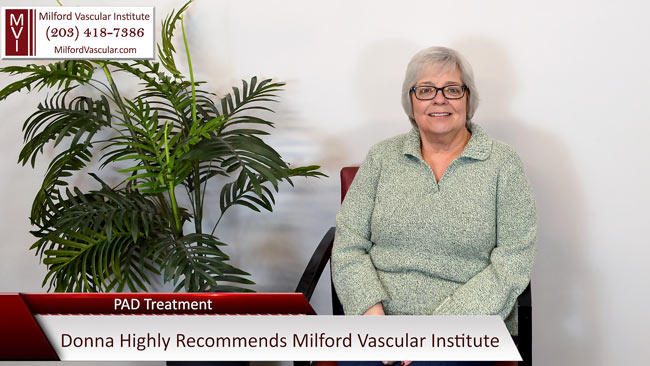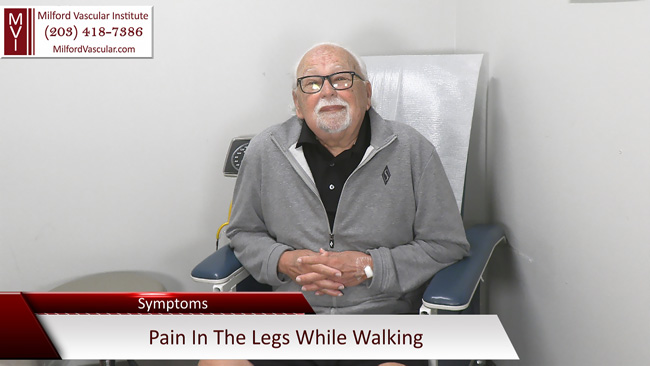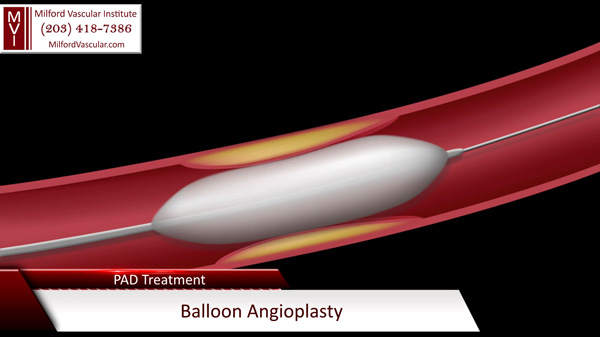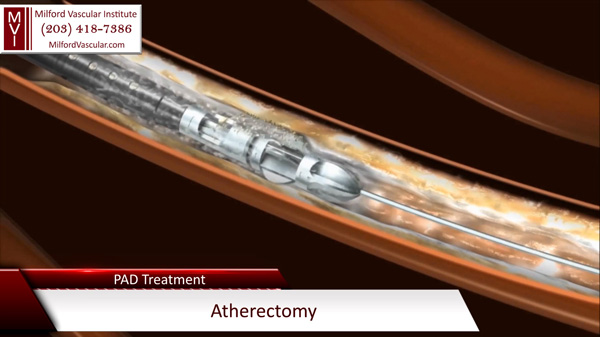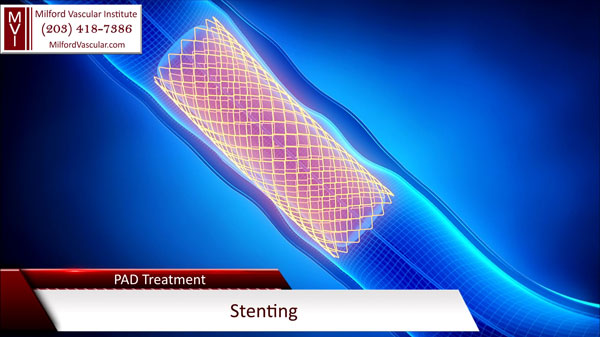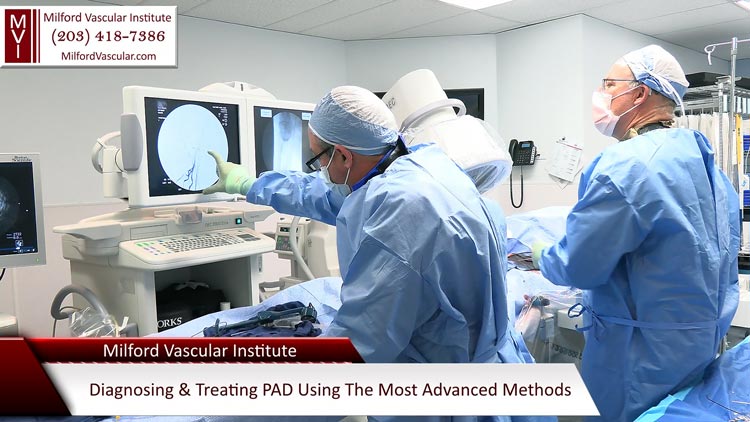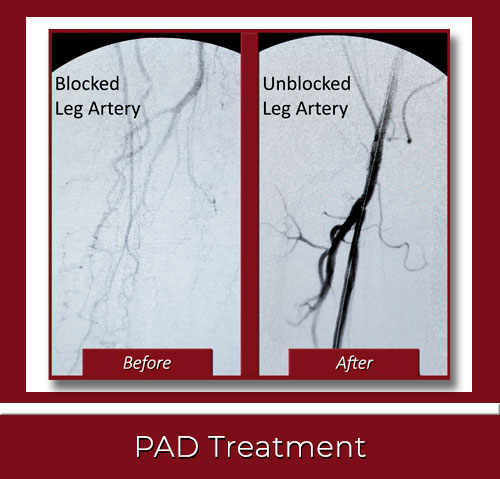
PAD Treatment by the Best Vascular Specialists Serving Milford, New Haven, Bridgeport, Stamford and All Of Southern Connecticut
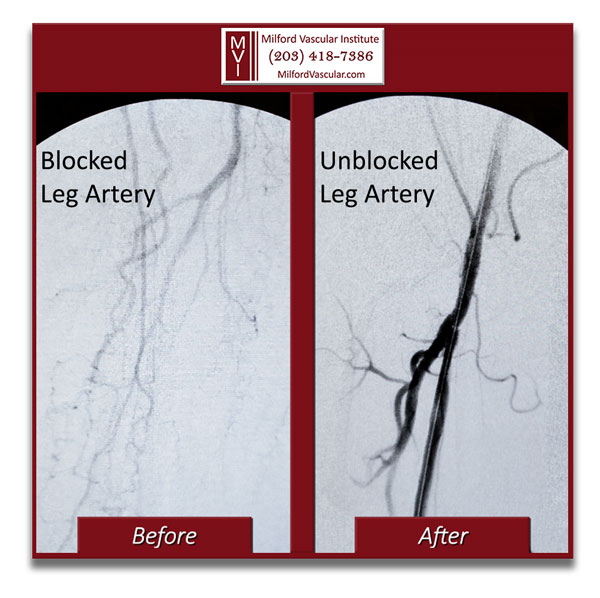
PAD treatment in New Haven County, performed by our expert vascular surgeon Dr. Esposito and interventional radiologist Dr. Davis will help put an end to your leg pain and help prevent possible amputation.
Using the most advanced minimally-invasive endovascular surgery methods available anywhere, at Milford Vascular Institute our vascular specialists can unblock your leg arteries to restore healthy blood circulation to your legs.
Our outpatient treatments for peripheral artery disease allow for no downtime, quick recovery and minimal to no scarring.
WHAT IS PERIPHERAL ARTERY DISEASE (PAD)?
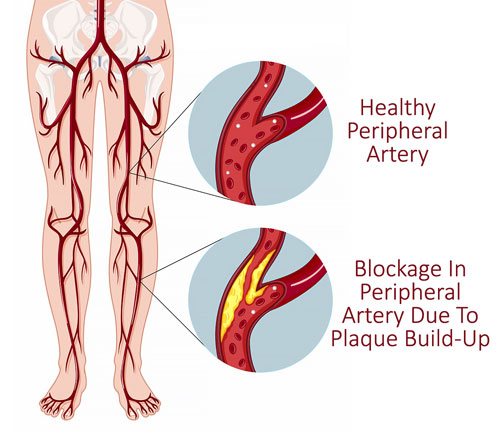
Peripheral arterial disease, also known as PAD, is a condition in which plaque builds up inside the leg arteries. This causes a constriction of blood flow within the artery.
The arteries carry blood that is rich in oxygen and nutrients down from the heart to the legs.
When blood flow to the legs becomes constricted due to PAD it can result in leg pain and leg cramps while walking. Left untreated, it can eventually lead to gangrene and amputation.
Dr. Esposito Explains Peripheral Arterial Disease Symptoms, Diagnosis and Treatment
“With patients who are diagnosed with peripheral arterial disease, the first step is modification of risk factors, which would be stop smoking, control your blood pressure, control your cholesterol, control your diabetes, and an active exercise program.
There are medications that we can use to try and improve blood flow by either making the platelets a little slippery or thinning the blood a little bit.
And a lot of times, using these conservative measures, that’s enough. The patients will have relief from their pain where they can at least do the things that they want to do. If it’s not, then we kind of move to the next step, which is intervention with surgeries or procedures to unblock the artery.”
~ Dr. David Esposito
Board Certified Vascular Surgeon
PERIPHERAL ARTERY DISEASE EXPERT DR. ESPOSITO
DISCUSSES PAD DANGERS & TREATMENTS
“In the last 20, 25 years, there’s really been a revolution in how we take care of patients with PAD. We can do that in a minimally-invasive way, what we would call endovascular, meaning working from the inside of the blood vessel.
Rather than doing a big operation, what we can do is get into the blood vessel through a needle and fix the blood vessel from the inside.
And we have numerous ways we can do that, using various balloons and stents and roto-rooter devices, where we can core out the blockages and remove the blockages that way and open up the blood vessel, but do it in a way that’s minimally-invasive.
So the patients are up walking almost right away without any incisions, and they go home right away and get back to work.”
~ Dr. David Esposito
Board Certified Vascular Surgeon
PAD Treatment Patient Testimonials
Patients Janet, Donna and Bob Share Their Experiences Having PAD Treatment With Dr. Esposito and Dr. Davis at Milford Vascular Institute
How Do We Unblock Arteries?
BALLOON ANGIOPLASTY WIDENS LEG ARTERIES THAT ARE CONSTRICTED BY PLAQUE BUILDUP
Through a small needle hole in the groin, a catheter is inserted into the artery. The balloon is attached to the catheter and is placed at the location of the blockage.
Once in place, the balloon is inflated. This pushes the plaque to the outer edges of the leg artery, widening the artery where it was previously constricted. With the artery widened, blood flow through the artery is improved.
ATHERECTOMY PHYSICALLY SCRAPES AWAY PLAQUE BUILDUP INSIDE THE LEG ARTERY
An atherectomy device is used to scrape away plaque buildup inside the leg artery that is causing blockage.
The atherectomy device aspirates the plaque particles out of the artery while it is scraping the plaque.
With the plaque physically removed from the walls of the artery, the artery can be fully opened once again, restoring healthy blood flow through the artery.
STENTING HELPS KEEP THE WIDENED ARTERY FROM NARROWING ONCE AGAIN
A stent is a wire mesh tube that is placed inside the leg artery at the location of blockage.
It is deployed, then pushed open using a balloon to lodge it securely against the arterial wall.
Once it is securely in place, the stent will act as reinforcement within the diseased artery to help prevent the artery from becoming constricted again.
Minimally-Invasive Outpatient Procedure
For Treating Peripheral Arterial Disease
Here at Milford Vascular Institute, our top-rated vascular specialists who are experts in treating PAD serve Milford, New Haven, Bridgeport, Stamford and all of Southern Connecticut, using the most advanced minimally-invasive techniques such as balloon angioplasty, atherectomy and stenting to unblock blocked leg arteries.
WATCH DR. ESPOSITO & DR. DAVIS UNBLOCK THIS PATIENT'S COMPLETELY BLOCKED LEG ARTERY
This 77-year-old patient was experiencing pain while walking that was relieved with rest.
After performing blood pressure tests and an ultrasound in our office, we diagnosed her with peripheral arterial disease that was causing blockage in her leg artery.
At Milford Vascular Institute’s office-based laboratory, board certified vascular surgeon Dr. Esposito, and board certified interventional radiologist Dr. Davis discovered that one of her leg arteries was completely blocked with plaque.
This was preventing healthy blood circulation to her lower legs.
Using the most advanced endovascular surgery methods available anywhere in the world, and by applying their skillful techniques, they were able to restore full blood flow through the blocked artery once again.
BEFORE AND AFTER PAD TREATMENT TO UNBLOCK BLOCKED LEG ARTERY
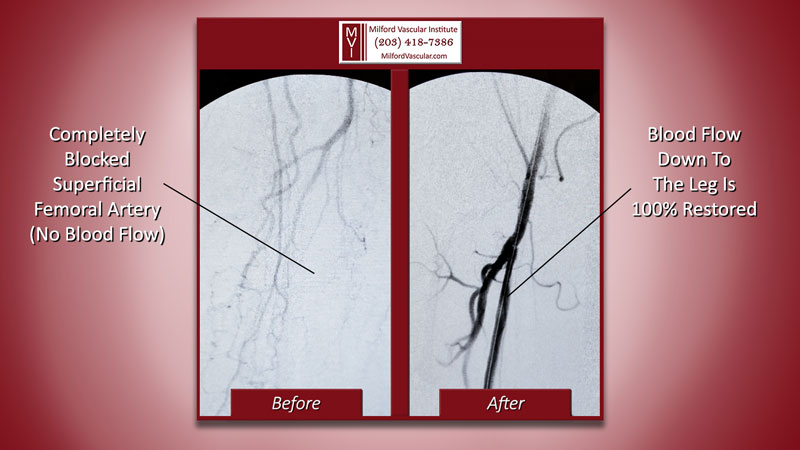
Following the outpatient procedure for PAD treatment, the patient will have no downtime, and will be able to resume her normal activities right away.
With healthy circulation restored through her leg, her symptoms of leg pain will resolve immediately. She will enjoy an improved quality of life and will be able to walk without pain again.
What Causes Peripheral Arterial Disease (PAD)?
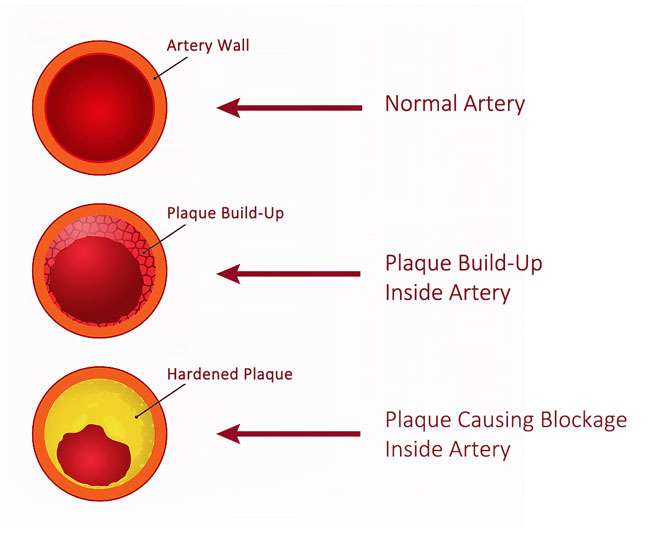
Peripheral arterial disease is the buildup of plaque inside the leg arteries.
There are certain risk factors that make it more likely for someone to develop plaque inside their arteries. They include:
-
- smoking
- high blood pressure
- diabetes
- high cholesterol
- having a family history of PAD
Peripheral Artery Disease Symptoms
PAIN IN THE LEGS WHILE WALKING THAT GOES AWAY WITH REST (CLAUDICATION)

Many people who have peripheral artery disease have mild symptoms, or no symptoms at all which makes it even harder to diagnose in its early stages.
The most evident symptom of peripheral arterial disease is something called claudication.
Claudication occurs when you feel leg pain or leg cramping in the calf muscle while walking that goes away once you stop walking and rest.
This occurs because of the lack of oxygen and nutrients being supplied to the calf muscles while they need them most (while walking). Since blood flow is constricted to the calf muscles, they do not receive the oxygen and nutrients they need to continue working without pain.
SYMPTOMS OF PERIPHERAL ARTERY DISEASE
If you are experiencing the symptoms of PAD, it is recommended to see a vascular specialist to discuss your symptoms and have a vascular evaluation.
A quick in-office blood pressure test and ultrasound can help determine if your symptoms are due to peripheral artery disease.
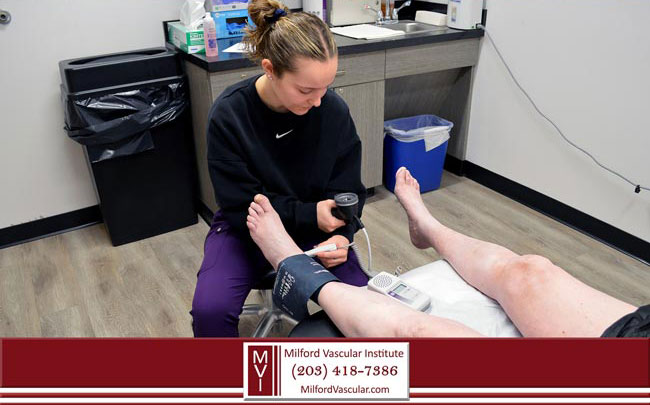
Why Choose
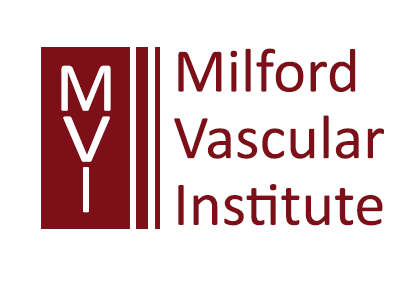
When you choose Milford Vascular Institute for treatment of peripheral arterial disease (PAD), you can rest assured that you are getting the very best possible vascular care available in all of New Haven County. Our vascular specialists are highly skilled in providing the most advanced, minimally-invasive vascular treatments available anywhere.
At MVI, board certified vascular surgeon Dr. David Esposito and Dr. Paul Davis, who is board certified in diagnostic radiology, and vascular and interventional radiology, will perform your PAD treatment in our office-based laboratory.
Dr. Esposito and Dr. Davis are top-rated experts in endovascular treatments. They are always at the forefront of technology in the vascular surgery field to ensure they are providing the best, cutting-edge vascular treatments to their community.
And if you require PAD surgery such as leg artery bypass or surgical plaque removal, Dr. Esposito has the expertise and experience to care for you in a hospital setting as well.
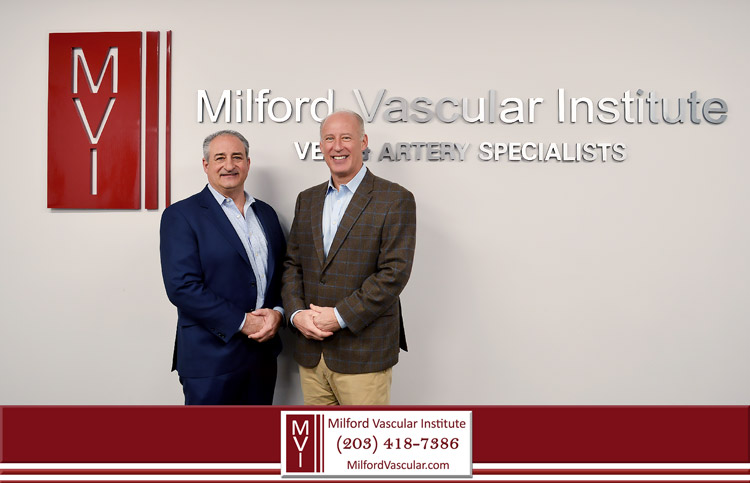
With over 50 years of combined experience in diagnosing, preventing and treating vascular diseases, our outstanding vascular specialists have dedicated their lives to caring for you.
With over 20 years in practice, at Milford Vascular Institute, our staff is committed to excellent patient care. We always treat our patients with respect and compassion because WE CARE.
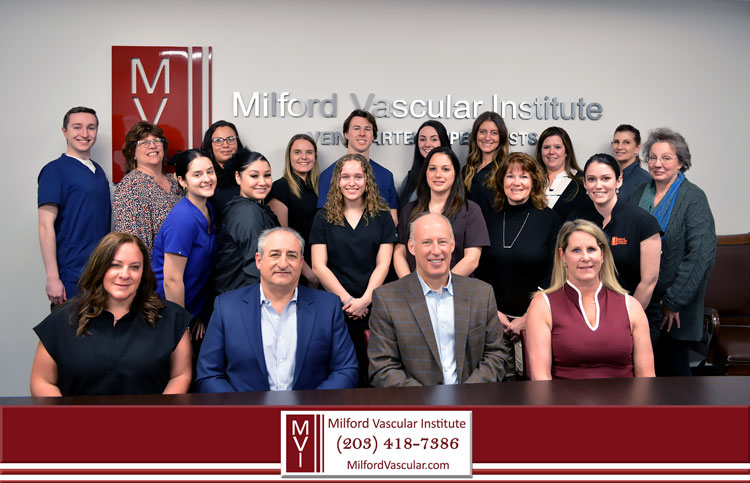
Our MVI Team ~ Always Treating You Like Family
If you’ve started to experience leg pain and leg cramps while walking, or any of the symptoms associated with peripheral arterial disease (PAD), it is important to have an evaluation with a vascular specialist as soon as possible. If left untreated, PAD can eventually lead to gangrene that may require amputation.
Through a simple in-office consultation, a blood pressure test and ultrasound, we can determine if your symptoms are due to a blockage in the leg arteries (PAD). If so, we can easily diagnose and often unblock your artery right in our office-based laboratory.
PAD treatment takes less than an hour to perform, is minimally-invasive, and performed on an outpatient basis under light sedation.
You will be able to go home and resume normal activities, with no downtime and quick recovery.
To schedule a consultation with one of our top-rated vascular specialists here at Milford Vascular Institute, give us a call today at (203) 418-7386. It will be our pleasure to care for you.

